Push notifications vs. Emails

In today’s digital age, effective communication is key for businesses striving to engage and retain customers. Among the plethora of communication channels available, push notifications and emails stand out as two prominent contenders. Both serve as invaluable tools for reaching audiences, but each has its own strengths and weaknesses. Understanding the nuances of push notifications and emails is crucial for businesses seeking to optimize their communication strategies and foster meaningful connections with their target audience.
The Power of Push Notifications
Push notifications, characterized by their real-time delivery and succinct messaging, have become ubiquitous in the mobile era. These bite-sized messages pop up on users’ devices, capturing attention with immediacy. Whether it’s a breaking news alert, a promotional offer, or a reminder, push notifications excel at delivering time-sensitive information directly to users’ screens. Their ability to cut through the noise of daily digital interactions makes them particularly effective for grabbing attention and driving immediate action.
The Strength of Email Marketing
On the other hand, emails offer a more versatile and comprehensive platform for communication. With ample space for detailed content, including images, links, and attachments, emails enable businesses to convey complex messages and foster deeper engagement. Additionally, emails provide users with the flexibility to consume content at their convenience, allowing them to prioritize and revisit messages at a later time. This asynchronous nature of email communication lends itself well to nurturing long-term relationships and delivering personalized content tailored to individual preferences.
When to Use Push, When to Use Email
While both push notifications and emails have their merits, the optimal choice depends on the nature of the message and the desired outcome. Push notifications excel in scenarios where immediacy is paramount, such as time-sensitive promotions, transactional updates, or urgent alerts. Their ability to capture attention in real-time makes them invaluable for driving immediate responses and encouraging swift decision-making.
On the contrary, emails shine in situations that require a more nuanced approach or deeper engagement. From newsletters and product updates to personalized recommendations and follow-up communications, emails offer the space and flexibility needed to deliver rich, multimedia content that resonates with recipients over time. Moreover, emails provide businesses with valuable data insights, allowing them to track open rates, click-through rates, and other metrics to measure the effectiveness of their campaigns and refine their strategies accordingly.
Limitations and Risks of Both Channels
Despite their distinct advantages, both push notifications and emails have their limitations. Push notifications risk being perceived as intrusive if overused or irrelevant to the recipient, leading to user opt-outs or app uninstalls. Similarly, emails run the risk of being ignored or relegated to the spam folder if they fail to capture the recipient’s interest or deliver value. To mitigate these risks, businesses must strike a balance between frequency, relevance, and personalization, ensuring that their communications resonate with recipients and align with their preferences and expectations.
Conclusion
In conclusion, the debate between push notifications and emails is not about choosing one over the other but rather leveraging each channel strategically based on its strengths and suitability for the message at hand. By understanding the unique characteristics of push notifications and emails and tailoring their communication strategies accordingly, businesses can effectively engage their audience, nurture relationships, and drive desired outcomes in today’s dynamic digital landscape.
Like what you’re reading?
Push0 is a privacy-first push notification service built for devs and marketers who care.
Try it free for 14 days — no credit card, no fluff.



